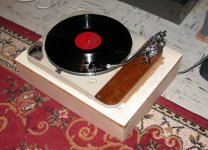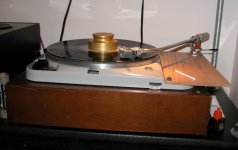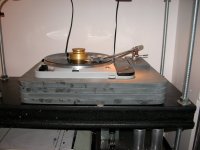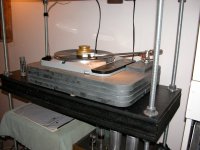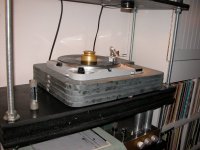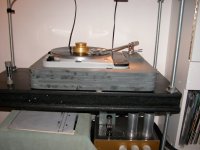Sell them Kevin and try and find a decent FR64S...[NOT 64FX]... You won't regret it!
No, don't sell them to me!
Concurrent experience, then. I noticed the FL-belt was tight when I received it, and stretched it overnight before installing it - made certain it was equally tensed around the spherical object I used to stretch it.
Advantage - completely silent belt. But I had to reduce the influence of the eddy brake, to get the deck up to the proper speed. And the speed does vary - while I had perfect speed compliance with the belt that created a whirr.
I'm now running the old belt, which is thinner than both the official and the Florida belts, and also narrower - about the same length, though without the same tension, as it's been used a lot.
This belt has the deck up to speed in one spin, is completely silent, and will give up the ghost one day - so I have to find something similar.
Official belt smudges; Florida belt can't make up its mind as to speed. But I haven't tried boiling or rubbing it in alcohol. Did notice that the FL-belt left quite a bit of rubber powder after the initial hours of spin, and this may have served almost as talc and therefore reduced friction.
Will give it another try, as Kevin has had good experiences with it. Will boil and rub the belts.
I'm now wondering how consistent the supply of those belts from "pleasebyme" in FLA on eBay actually are. I've had nothing but good luck with the half dozen I have purchased - and I've installed them on 4 machines with no difficulties so far, but given how he sources these it may well be that mine came from another supplier. All were the same length as a new Thorens OEM replacement, (Thakker) and somewhat thinner as I recall (refer back to my earlier posts on the subject) - after some months of running my table is still running quietly, and speed stability is and has always been very consistent. The Thorens OEM replacement belt leaves gooey residue all over my pulleys which is why I no longer use it, but was slightly quieter when clean.
A couple of comments on cleaning belts. I wash mine in hot soapy water, and avoid using isopropyl alcohol on them as depending on the rubber formulation it may degrade it. I dust them with talcum powder and clean the pulleys prior to installing a new belt.
I also still have the original belt that came with the table when new (according to the original owner - never touched or replaced) and this belt is significantly different than any of the replacement belts I have looked at being both thinner and more elastic than any new one I have yet found. Stretched length is the same as the new belts once they have "relaxed" a bit in use. Stretching unless done uniformly can cause speed stability issues IMLE.. All belts should stretch in use. My observation is that the original belt runs quietest of all, and provides consistent performance, but I have had good results with the FLA belts referenced. (I keep my as a reference in a sealed bag in a cool, and dark place)
Last edited:
I haven't tried this (yet) with my TD 124, but a trick my cousin told me a long time ago comes to mind. You can use a too-long belt if you cut it to size on the diagonal (45 degree cut) and then glue it back together again with superglue. I have used this before with various drive belts, (and it worked very well for years) but not with my TD 124. The diagonal cut is to minimize any vibration being transferred to the unit when the cut and gluerd part of the belt runs over the pully.
In this thread, many of us have discussed noise in the transmission of power from the motor to the platter.
There have been several ways discussed in ways to detect it, I discovered a new one.
I bought a baby heartbeat monitor today at a thrift store, and it is very sensitive, and does the job well. It cost me all of $5.00 and was well worth it.
BTW, my Td124 does name some noise, but little of it is transmitted to the platter or the armboard.
There have been several ways discussed in ways to detect it, I discovered a new one.
I bought a baby heartbeat monitor today at a thrift store, and it is very sensitive, and does the job well. It cost me all of $5.00 and was well worth it.
BTW, my Td124 does name some noise, but little of it is transmitted to the platter or the armboard.
In this thread, many of us have discussed noise in the transmission of power from the motor to the platter.
There have been several ways discussed in ways to detect it, I discovered a new one.
I bought a baby heartbeat monitor today at a thrift store, and it is very sensitive, and does the job well. It cost me all of $5.00 and was well worth it.
BTW, my Td124 does name some noise, but little of it is transmitted to the platter or the armboard.
Pretty clever, an approach I never thought of, I'm assuming the bandpass is sufficient for motor noise, rumble and most of the ills that plague these tables..
I have found the mechanic's stethoscope quite useful. One experiment you might find interesting is to listen to the chassis with an actual record playing and the volume turned down - this will give you a good idea of how much energy from the stylus is making it up through the cartridge, the arm tube, through the arm bearings and into the arm board and chassis. I was quite surprised how much energy was coupled by the ZU/SME combination into the chassis of the table.
Results are quite different with the Schick, it's just a whole lot better damped than the SME 3009, and the additional mass I guess provides a sink for a lot of the energy. I can hear a little in my ersatz arm board which probably is not very tightly coupled to the chassis. I do hear plenty of motor noise, it now dominates whereas with the SME the noise coupled from arm dominated. Just anecdotal..
My new slate plinth will be arriving next week. Can't wait to set it up. My understanding is that a good plinth can be worth 15dB or more reduction in mechanical noise levels.
Last edited:
My new slate plinth will be arriving next week. Can't wait to set it up. My understanding is that a good plinth can be worth 15dB or more reduction in mechanical noise levels.
I hear also good noise reduction with the new plinth. The extra rubber-pads between the hard rubber-feet and plinth absorb energy and the new mushroom work also fine.
So I think when users are mounting their frame direct to the plinth some higher rumble frequencies will be amplified by that. It is not the right approach I think.
Absorption on a very sub low frequency is better.
With the coupling of the TD124 on it is easy to use the cartridge to measure noise with the stylus on the platter. That noise is the one that count.
I've posted a couple of pictures of what I am tinkering with/listening to lately..
The first is my "Ersatz TD-124" this little machine was cannibalized at some point to upgrade a TD-121 which is what this machine has temporarily become. Currently it is fitted out as a TD-121 with a combination of the parts that were given to me with it and a few bits and pieces I've cobbled together. The SME 3009 Series II has an ancient Stanton 681 (with original stylus on it) installed and it actually sounds pretty good. Rumble and noise levels are acceptable although significantly higher than the TD-124/II.
The TD-124/II is currently equipped with a very wimpy temporary arm board with my new Schick on it. The head shell is an Orsonic and the cartridge is my trusty old ZU. The Schick is equipped with the heavier counter-weight. This combo performs at a whole other level compared to this table with the SME arm and ZU cartridge. My new slate plinth is on its way and should be here within a week or so.
The first is my "Ersatz TD-124" this little machine was cannibalized at some point to upgrade a TD-121 which is what this machine has temporarily become. Currently it is fitted out as a TD-121 with a combination of the parts that were given to me with it and a few bits and pieces I've cobbled together. The SME 3009 Series II has an ancient Stanton 681 (with original stylus on it) installed and it actually sounds pretty good. Rumble and noise levels are acceptable although significantly higher than the TD-124/II.
The TD-124/II is currently equipped with a very wimpy temporary arm board with my new Schick on it. The head shell is an Orsonic and the cartridge is my trusty old ZU. The Schick is equipped with the heavier counter-weight. This combo performs at a whole other level compared to this table with the SME arm and ZU cartridge. My new slate plinth is on its way and should be here within a week or so.
Attachments
A few days ago my friend from Vietnam arrived home with the heartbreaking news that the airport security in Los Angeles had unpacked the plinth components and failed to repack them correctly - with the exception of the one piece that was in his suitcase the other pieces all got broken in a minimum of 4 places and in most cases about twice that many locations.
We spent most of the morning piecing the broken pieces back together with devcon epoxy - while not unscarred we were successful and I have a functional slate plinth. It actually works extremely well - the mechanical noise floor is significantly improved - in fact the only noise in playback now is the tracing noise in the grooves, there is no audible noise from the table at all.
The good news is he will ship me another when he gets back and this one will be used with my other TD-124 which will also benefit a lot.
The plinth weighs 80lbs..
We spent most of the morning piecing the broken pieces back together with devcon epoxy - while not unscarred we were successful and I have a functional slate plinth. It actually works extremely well - the mechanical noise floor is significantly improved - in fact the only noise in playback now is the tracing noise in the grooves, there is no audible noise from the table at all.
The good news is he will ship me another when he gets back and this one will be used with my other TD-124 which will also benefit a lot.
The plinth weighs 80lbs..
Attachments
Heartbreaking news indeed.
When the replacement plinth finally does arrive, the broken parts we're seeing now in your photos should serve well as spare pieces of slate for several different uses. I've found in my own messing around that thick heavy blocks of slate make good footers beneath TT plinths, etc. Other components as well.
By now, you must be hearing the true potential of that Thorens. I know that once I had mine (2729) in slate, I felt no need to experiment with other plinth ideas.
I've seen some examples where the slate plinths are coated in automotive finishes. (acrylic enamel, Imron, lacquers, etc) Others where the slate is unfinished but wiped down with boiled Linseed Oil. I've used this on mine. It darkens and deepens the finish very nicely on slate.
later,
-Steve
When the replacement plinth finally does arrive, the broken parts we're seeing now in your photos should serve well as spare pieces of slate for several different uses. I've found in my own messing around that thick heavy blocks of slate make good footers beneath TT plinths, etc. Other components as well.
By now, you must be hearing the true potential of that Thorens. I know that once I had mine (2729) in slate, I felt no need to experiment with other plinth ideas.
I've seen some examples where the slate plinths are coated in automotive finishes. (acrylic enamel, Imron, lacquers, etc) Others where the slate is unfinished but wiped down with boiled Linseed Oil. I've used this on mine. It darkens and deepens the finish very nicely on slate.
later,
-Steve
About twelve years ago I called Customs to find out how I could be compensated for damage done by customs officials when they examined a package that had arrived into DFW from Canada. The person on the other end of the line literally laughed out loud. I can't tell you how much that experience reinforced the notion I already had that customs officials are mostly a bunch of gangsters.
John
John
The sad thing about this is conceptually this plinth works perfectly. The top two layers and the bottom two layers are different in order to maximize the mass of the plinth.
This plinth will live on as the plinth for my secondary TD-124 once I have one that has arrived intact.
I would have oiled the plinth had it survived intact, but because of the damage and the need to epoxy it I haven't bothered.
I'm hoping the next one can get here unscathed by air-freight. It will be packed extremely carefully..
The silence on the lead in and lead out grooves is uncanny, there is literally no noise at all other than the tracing noise.
It was to be the culmination of my TT project, now that will have to wait.. OTOH I will have two functional plinths and tables.
In any case the end result is nothing short of amazing..

This plinth will live on as the plinth for my secondary TD-124 once I have one that has arrived intact.
I would have oiled the plinth had it survived intact, but because of the damage and the need to epoxy it I haven't bothered.
I'm hoping the next one can get here unscathed by air-freight. It will be packed extremely carefully..
The silence on the lead in and lead out grooves is uncanny, there is literally no noise at all other than the tracing noise.
It was to be the culmination of my TT project, now that will have to wait.. OTOH I will have two functional plinths and tables.
In any case the end result is nothing short of amazing..
About twelve years ago I called Customs to find out how I could be compensated for damage done by customs officials when they examined a package that had arrived into DFW from Canada. The person on the other end of the line literally laughed out loud. I can't tell you how much that experience reinforced the notion I already had that customs officials are mostly a bunch of gangsters.
John
Sadly I have been through much the same thing with US Customs here in Boston - about a decade ago they and the freight forwarder were jointly responsible for doing several thousands of dollars of damage to some KTA amplifiers shipped here from my then OEM in Hong Kong. UPS then managed to destroy another one, only 3 miles from the client's residence (it fell out of the open back of the truck, the crate it was in was not enough to save it) - I did finally get paid for that one at least, but it was the last straw and my business ended on a very sour note..
A few days ago my friend from Vietnam arrived home with the heartbreaking news that the airport security in Los Angeles had unpacked the plinth components and failed to repack them correctly - with the exception of the one piece that was in his suitcase the other pieces all got broken in a minimum of 4 places and in most cases about twice that many locations.
I wish you strength with dealing with this huge disappointment. I can imagine the feeling when longing long for the plinth and then damaged by such a foolish way.
I had some trouble with damaging the paint when mounting always the same thing.
But Kevin there can be no climax when there is no disappointment. After this low it can only can become better. It is a good thing you can test the functionality of the slate-material.
Kevin,
Have you thought of having at least the sides, if not the top, covered with a slate veneer about 1/4" thick? OR you could use many other materials. A friend has a 301 in slate which had bad chips and that is just what he did. Although it no longer looks as good as in bare slate it performs perfectly and looks undamaged in its rosewood "skin".
Have you thought of having at least the sides, if not the top, covered with a slate veneer about 1/4" thick? OR you could use many other materials. A friend has a 301 in slate which had bad chips and that is just what he did. Although it no longer looks as good as in bare slate it performs perfectly and looks undamaged in its rosewood "skin".
Kevin,
Have you thought of having at least the sides, if not the top, covered with a slate veneer about 1/4" thick? OR you could use many other materials. A friend has a 301 in slate which had bad chips and that is just what he did. Although it no longer looks as good as in bare slate it performs perfectly and looks undamaged in its rosewood "skin".
I'm thinking of possibly doing something along those lines, but I will be getting a replacement in any event. This one works very well and I might try one of several possibilities to spruce it up, OTOH as it is functional I may leave it as is - a reminder..
not to change the subject away from slate plinths shipped in from abroad and careless/ignorant custom's inspectors, but I have some further thoughts/observations regarding speed pitch control on the TD124 and its general ability to hold speed throughout the day, day-in, day-out over time.
re: speed pitch and the Td124.
Let's imagine another vinyl enthusiast. A record collector. A vinyl spinning kind of guy who is a lot like us, except that he's not really into the 'build it yourself' kind of thing. He reads all the recent internet chat about the various TD124 rehabilitation and re-plinth projects. He reads Art Dudley. Get's the bug and decides to try a TD124. So now 'vintage' is the way to go.
He checks out the Schopper catalog and sees the photo there of the gent in the suit posed over a fixture set up with multiple mounted E-50 motors all having being serviced, run-in for a week, disassembled, then re-adjusted for bushing alignments and quietest/coolest running.
Maybe he's been a vinyl enthusiast for many years. Perhaps all his life. Previous turntables may include an Lp12, or an AR or may be an Oracle. You know, belt drives with synchronous AC motors. But now he wants to get that 'idler thrust' thing going in the listening room. What should we tell this guy he has a right to expect in terms of speed pitch consistency and the TD124?!
re: listening.
There should be no wavering solo piano notes. I hear Glen Gould Bach piano notes as a nice solid pitch.
Notes should never be out of tune. Neither flat nor sharp. Even a pitch sensitive ear should be satisfied that what is heard is not the result of incorrect platter speed, but what was recorded to the Lp.
re: looking at the strobe.
My comments with regard to my obsessive strobe watching over the past few years with #2729 and the others I've had the pleasure to work on.
With regard to #2729, it has had all of the service maintenance as detailed here and also described at my website for the three TD124 refurb projects that I have detailed there:
TD124 Dept
It's late June, 2011 in the Pacific Northwest part of the United States. (I think it was 2007 when I refurbished 2729. ) Ambient temperatures in the room are around 68 deg F at the coolest and up to around 74-76 during the day.
I tend to play records on my TD124 nearly every day for at least a short period of time. But I turn the motor on when I get home from work and allow it time to warm up and get speed stable. I won't turn it off until I'm sure I'm done listening for the day.
Usually on a cold start I have a slightly slow strobe but still playable speed within a minute after switch on. I've seen it get speed stable after a few revs on a cold start. Other days it takes longer. This summer, when it gets hotter, the unit will get up to speed quicker.
Typically, when I've been playing the TD124 for long periods each day for several days in a row, I see the best cold start-up times. The deck displays its best speed pitch stability. And strobe tends to give the impression of being "locked" into 33-1/3rd rpms by an apparently un-moving strobe display.
However, if it has been several days since I've played the deck, it will be slow to come up to speed, takes more than a few seconds to get up to a playable speed, but still less than a minute. During the day, the strobe may indicate some speed drift. Drift in either direction, going slightly fast or slow. but always correctable by a very slight adjustment to the pitch control knob.
Other days, there is no speed drift. I blame it on the shaded pole motor. The E-50. In any case, as beautiful as they are, these machines are dinosaurs.

In the above image the cross shaped knob within the speed select lever, is the speed pitch adjuster. The pitch adjuster allows for just 1 revolution of the knob. You can turn the knob beyond in either direction all day until the cows come back home, but to no effect. There is a spring/disc drive mechanism that allows the the drive to slip when the knob has been adjusted beyond the range of the eddy brake at the other end of the connecting rod

It might be confusing, for someone who has never disassembled one of these units, to get a feel for this knob. Perhaps even get lost having adjusted the knob too far and not seen any change in response to that adjustment. In short, when the adjuster knob is at the full range of its adjustment in one direction or the other, (up against a stop so to speak), there will be a sharp but light amount of additional resistance felt as the adjuster is rotated beyond its useful range. No harm is done. But to no effect. There is a spring loaded disk that propels a flat bar by means of spring pressure pressing the disk against the face of the bar. When the bar has been driven to its one extreme or opposite extreme, the spring loaded disk simply slips against the driven surface of the flat bar. This doesn't hurt anything, but the operator should get the idea when he keeps twisting the stupid knob and hasn't seen any change in strobe behavior.
----------------
Btw, my power supply to the TT is isolated from the mains and adjustable for volts out. I set it for 120 vac. My multi-meter tends to measure the incoming voltage at around 119 vac. Close enough. This turntable seems to be happy there.
The motor is a shaded pole AC motor. Mains frequency amounts for about 85% of its speed contribution, the other contributors are torque load (10%) and drive voltage (5%).
Consider the eddy brake as part of the torque load controlling ultimate motor rpm, but the other parts of the load will be platter mass, assorted drive train inefficiencies (belt drag, various pulley-shaft/bushing drag, idler wheel force loading, etc)
-Steve
re: speed pitch and the Td124.
Let's imagine another vinyl enthusiast. A record collector. A vinyl spinning kind of guy who is a lot like us, except that he's not really into the 'build it yourself' kind of thing. He reads all the recent internet chat about the various TD124 rehabilitation and re-plinth projects. He reads Art Dudley. Get's the bug and decides to try a TD124. So now 'vintage' is the way to go.
He checks out the Schopper catalog and sees the photo there of the gent in the suit posed over a fixture set up with multiple mounted E-50 motors all having being serviced, run-in for a week, disassembled, then re-adjusted for bushing alignments and quietest/coolest running.
Maybe he's been a vinyl enthusiast for many years. Perhaps all his life. Previous turntables may include an Lp12, or an AR or may be an Oracle. You know, belt drives with synchronous AC motors. But now he wants to get that 'idler thrust' thing going in the listening room. What should we tell this guy he has a right to expect in terms of speed pitch consistency and the TD124?!
re: listening.
There should be no wavering solo piano notes. I hear Glen Gould Bach piano notes as a nice solid pitch.
Notes should never be out of tune. Neither flat nor sharp. Even a pitch sensitive ear should be satisfied that what is heard is not the result of incorrect platter speed, but what was recorded to the Lp.
re: looking at the strobe.
My comments with regard to my obsessive strobe watching over the past few years with #2729 and the others I've had the pleasure to work on.
With regard to #2729, it has had all of the service maintenance as detailed here and also described at my website for the three TD124 refurb projects that I have detailed there:
TD124 Dept
It's late June, 2011 in the Pacific Northwest part of the United States. (I think it was 2007 when I refurbished 2729. ) Ambient temperatures in the room are around 68 deg F at the coolest and up to around 74-76 during the day.
I tend to play records on my TD124 nearly every day for at least a short period of time. But I turn the motor on when I get home from work and allow it time to warm up and get speed stable. I won't turn it off until I'm sure I'm done listening for the day.
Usually on a cold start I have a slightly slow strobe but still playable speed within a minute after switch on. I've seen it get speed stable after a few revs on a cold start. Other days it takes longer. This summer, when it gets hotter, the unit will get up to speed quicker.
Typically, when I've been playing the TD124 for long periods each day for several days in a row, I see the best cold start-up times. The deck displays its best speed pitch stability. And strobe tends to give the impression of being "locked" into 33-1/3rd rpms by an apparently un-moving strobe display.
However, if it has been several days since I've played the deck, it will be slow to come up to speed, takes more than a few seconds to get up to a playable speed, but still less than a minute. During the day, the strobe may indicate some speed drift. Drift in either direction, going slightly fast or slow. but always correctable by a very slight adjustment to the pitch control knob.
Other days, there is no speed drift. I blame it on the shaded pole motor. The E-50. In any case, as beautiful as they are, these machines are dinosaurs.

In the above image the cross shaped knob within the speed select lever, is the speed pitch adjuster. The pitch adjuster allows for just 1 revolution of the knob. You can turn the knob beyond in either direction all day until the cows come back home, but to no effect. There is a spring/disc drive mechanism that allows the the drive to slip when the knob has been adjusted beyond the range of the eddy brake at the other end of the connecting rod

It might be confusing, for someone who has never disassembled one of these units, to get a feel for this knob. Perhaps even get lost having adjusted the knob too far and not seen any change in response to that adjustment. In short, when the adjuster knob is at the full range of its adjustment in one direction or the other, (up against a stop so to speak), there will be a sharp but light amount of additional resistance felt as the adjuster is rotated beyond its useful range. No harm is done. But to no effect. There is a spring loaded disk that propels a flat bar by means of spring pressure pressing the disk against the face of the bar. When the bar has been driven to its one extreme or opposite extreme, the spring loaded disk simply slips against the driven surface of the flat bar. This doesn't hurt anything, but the operator should get the idea when he keeps twisting the stupid knob and hasn't seen any change in strobe behavior.
----------------
Btw, my power supply to the TT is isolated from the mains and adjustable for volts out. I set it for 120 vac. My multi-meter tends to measure the incoming voltage at around 119 vac. Close enough. This turntable seems to be happy there.
The motor is a shaded pole AC motor. Mains frequency amounts for about 85% of its speed contribution, the other contributors are torque load (10%) and drive voltage (5%).
Consider the eddy brake as part of the torque load controlling ultimate motor rpm, but the other parts of the load will be platter mass, assorted drive train inefficiencies (belt drag, various pulley-shaft/bushing drag, idler wheel force loading, etc)
-Steve
My experience at this point generally parallels yours Steve. I generally turn the table on and let it warm up for about a minute and then play my first record, depending on room temperature it can take a few minutes to about 10 minutes to get up to full speed. (Note that even cold it is not noticeably slow) Once there I see no further drift over many hours of play and in fact I never tweak the speed adjustment unless I have just worked on the table - which mercifully is not very often now.
It gets a lot of use..
I've tried reducing the torque output by reducing supply voltage or by using the 150V tap in order to not force the eddy current brake to work so hard, but have found that the table takes much longer to come up to speed, and it also seems to loose that sense of pace & drive that I particularly like about it.
It gets a lot of use..
I've tried reducing the torque output by reducing supply voltage or by using the 150V tap in order to not force the eddy current brake to work so hard, but have found that the table takes much longer to come up to speed, and it also seems to loose that sense of pace & drive that I particularly like about it.
The silence on the lead in and lead out grooves is uncanny, there is literally no noise at all other than the tracing noise.
What about the sound? Any damping substances between the layers? Very unfortunate about the cracks but surely this is purely cosmetic.
So pleased with my Beogram 3000 Thorens that I've moved the tt and my vintage amplifier into my main listening room. My TD124 has been recently refurbished, and the motor is in very good condition - when being tested, it started turning at 28V AC, where I understand they typically start at 45V AC.
This shows, in that it reaches speed stability very fast - over the course of an evening I may have some drift, but I check between each record, and as Steve writes all that's needed is a little turning of the speed adjustment wheel, if necessary, to lock the speed.
And as he also mentions, it's a joy to listen to long piano notes, winds and brass that hold steady, without any hint of wavering. I have a belt driven Beogram 4000, and after getting the TD124 I'm spending very little time listening to the Bg4000 - the difference is noticeable.
My vintage units together with my Helsinki Gradient 1.5 speakers.
Detail, here with the 9"-tonearm:
Question to Steve - how often should one lubricate the main bearing?
This shows, in that it reaches speed stability very fast - over the course of an evening I may have some drift, but I check between each record, and as Steve writes all that's needed is a little turning of the speed adjustment wheel, if necessary, to lock the speed.
And as he also mentions, it's a joy to listen to long piano notes, winds and brass that hold steady, without any hint of wavering. I have a belt driven Beogram 4000, and after getting the TD124 I'm spending very little time listening to the Bg4000 - the difference is noticeable.
My vintage units together with my Helsinki Gradient 1.5 speakers.
An externally hosted image should be here but it was not working when we last tested it.
Detail, here with the 9"-tonearm:
An externally hosted image should be here but it was not working when we last tested it.
Question to Steve - how often should one lubricate the main bearing?
- Home
- Source & Line
- Analogue Source
- Restoring and Improving A Thorens TD-124 MKII
